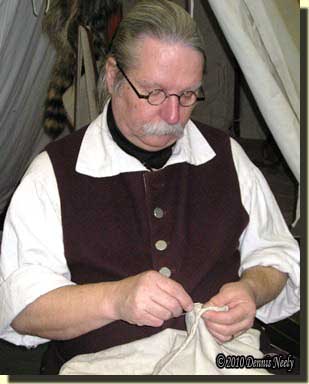“But I Can’t Sew…”
“Our clothing was all of domestic manufacture…” (Doddridge, 113)
Stitches are the nails, screws and bolts of garment construction. I offer this analogy because when I begin to discuss sewing with a newcomer to traditional black powder hunting, I often see trepidation wash over that individual’s face. The next words I hear are: “But I can’t sew.”
Most times it is the men that say this, but in recent years, women do, too. “Are you handy?” “Do you do home repairs?” “Do you work on cars, or do you know your way around a machine shop?” and “Do you do construction?” are common questions I pose to the men. “Do you have a hobby that requires skill with your hands?” “Do you cook?” “Do you scrapbook or knit?” or “Do you make jewelry?” are common questions for the women. A “Yes” to any of these questions opens the door for a meaningful discussion about sewing stitches and historical garment construction techniques.
 Fine sewing is considered an art, but all that is really necessary to produced satisfactory results is basic eye-hand coordination, a willingness to experiment and a desire to persevere. An ability to read and follow instructions is helpful (please read that as “a must”), and like any other living history task, research is also an important factor in the selection and making of any period-correct garment. Learning to sew is not always easy, but wearing a garment manufactured with one’s own hands adds to the joy of any woodland sojourn. For traditional hunters just starting out, one of the best reference manuals is Beth Gilgun’s Tidings from the 18th Century.
Fine sewing is considered an art, but all that is really necessary to produced satisfactory results is basic eye-hand coordination, a willingness to experiment and a desire to persevere. An ability to read and follow instructions is helpful (please read that as “a must”), and like any other living history task, research is also an important factor in the selection and making of any period-correct garment. Learning to sew is not always easy, but wearing a garment manufactured with one’s own hands adds to the joy of any woodland sojourn. For traditional hunters just starting out, one of the best reference manuals is Beth Gilgun’s Tidings from the 18th Century.
Like the carpenter’s soft maple, yellow pine and black walnut, natural fabrics vary in texture, composition and working qualities. Each fabric has its own characteristics, peculiarities and handling practices, just as each wood does, which is why a reference manual is such a valuable asset when learning to sew—a family member who sews can be a great help, too.
Power Tools vs. Hand Tools
On today’s construction jobsites, speed and efficiency are the watchwords, which is why power tools are employed wherever possible. But when it comes to sewing that was not the case during my chosen era, 1790 to 1799; the first functioning sewing machine had not yet been manufactured. All garments and accoutrements were handmade and hand sewn.
Like air-nailers and cordless saws, sewing machines exist today, and are employed by re-enactors in varying degrees, most often for time-saving and convenience. Some reproduction garments are sewn entirely by machine (“machine sewn”); for others, the seams that will not show are machine sewn, while the visible seams are hand sewn to give a more authentic appearance (“machine sewn and hand finished”); and those folks who wish to produce a period-correct reproduction hand sew the entire garment (“hand sewn”). My first set of traditional clothing was all machine sewn, but as I progressed down the path to yesteryear I shifted to machine sewn and hand finished, and now I want my clothing and accoutrements to reflect the authenticity that my research demands, so I choose hand sewing.
Over the years I have come to view all seams in terms of performance in light of the original maker’s stitch choice, a choice that centered on strength, durability and efficiency. In hindsight, I realize why some of my early machine sewn seams failed in the wilderness classroom. I see the wisdom of the 18th-century seamstresses and tailors, which is akin to using bolts to secure a beam, rather than nails or screws. With that in mind, I encourage all newcomers to start their learning process with hand sewing.
So when someone says, “But I can’t sew,” I start asking questions. If that individual answers “Yes” to any of those questions, I usually respond with “Actually, you can sew!”
Start a traditional sewing project today, be safe and may God bless you.
